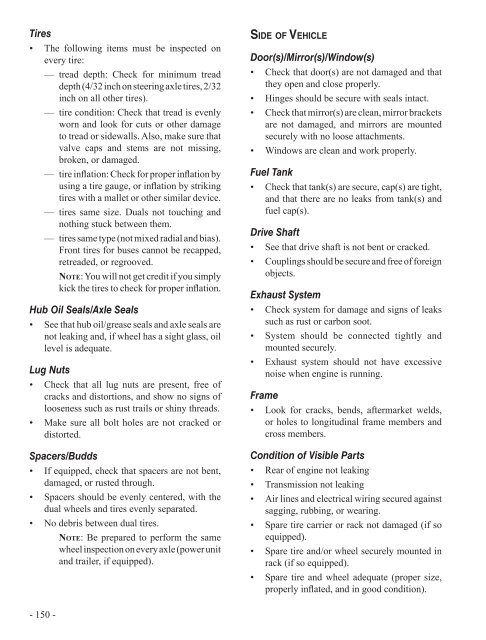Commercial Driver Handbook ( PDF ) - California Department of ...
Commercial Driver Handbook ( PDF ) - California Department of ...
Commercial Driver Handbook ( PDF ) - California Department of ...
Create successful ePaper yourself
Turn your PDF publications into a flip-book with our unique Google optimized e-Paper software.
Tires<br />
• The following items must be inspected on<br />
every tire:<br />
— tread depth: Check for minimum tread<br />
depth (4/32 inch on steering axle tires, 2/32<br />
inch on all other tires).<br />
— tire condition: Check that tread is evenly<br />
worn and look for cuts or other damage<br />
to tread or sidewalls. Also, make sure that<br />
valve caps and stems are not missing,<br />
broken, or damaged.<br />
— tire inflation: Check for proper inflation by<br />
using a tire gauge, or inflation by striking<br />
tires with a mallet or other similar device.<br />
— tires same size. Duals not touching and<br />
nothing stuck between them.<br />
— tires same type (not mixed radial and bias).<br />
Front tires for buses cannot be recapped,<br />
retreaded, or regrooved.<br />
Note: You will not get credit if you simply<br />
kick the tires to check for proper inflation.<br />
Hub Oil Seals/Axle Seals<br />
• See that hub oil/grease seals and axle seals are<br />
not leaking and, if wheel has a sight glass, oil<br />
level is adequate.<br />
Lug nuts<br />
• Check that all lug nuts are present, free <strong>of</strong><br />
cracks and distortions, and show no signs <strong>of</strong><br />
looseness such as rust trails or shiny threads.<br />
• Make sure all bolt holes are not cracked or<br />
distorted.<br />
Spacers/Budds<br />
• If equipped, check that spacers are not bent,<br />
damaged, or rusted through.<br />
• Spacers should be evenly centered, with the<br />
dual wheels and tires evenly separated.<br />
• No debris between dual tires.<br />
Note: Be prepared to perform the same<br />
wheel inspection on every axle (power unit<br />
and trailer, if equipped).<br />
- 150 -<br />
side <strong>of</strong> vehiCle<br />
Door(s)/Mirror(s)/Window(s)<br />
• Check that door(s) are not damaged and that<br />
they open and close properly.<br />
• Hinges should be secure with seals intact.<br />
• Check that mirror(s) are clean, mirror brackets<br />
are not damaged, and mirrors are mounted<br />
securely with no loose attachments.<br />
• Windows are clean and work properly.<br />
Fuel Tank<br />
• Check that tank(s) are secure, cap(s) are tight,<br />
and that there are no leaks from tank(s) and<br />
fuel cap(s).<br />
Drive Shaft<br />
• See that drive shaft is not bent or cracked.<br />
• Couplings should be secure and free <strong>of</strong> foreign<br />
objects.<br />
Exhaust System<br />
• Check system for damage and signs <strong>of</strong> leaks<br />
such as rust or carbon soot.<br />
• System should be connected tightly and<br />
mounted securely.<br />
• Exhaust system should not have excessive<br />
noise when engine is running.<br />
Frame<br />
• Look for cracks, bends, aftermarket welds,<br />
or holes to longitudinal frame members and<br />
cross members.<br />
Condition <strong>of</strong> Visible Parts<br />
• Rear <strong>of</strong> engine not leaking<br />
• Transmission not leaking<br />
• Air lines and electrical wiring secured against<br />
sagging, rubbing, or wearing.<br />
• Spare tire carrier or rack not damaged (if so<br />
equipped).<br />
• Spare tire and/or wheel securely mounted in<br />
rack (if so equipped).<br />
• Spare tire and wheel adequate (proper size,<br />
properly inflated, and in good condition).

















